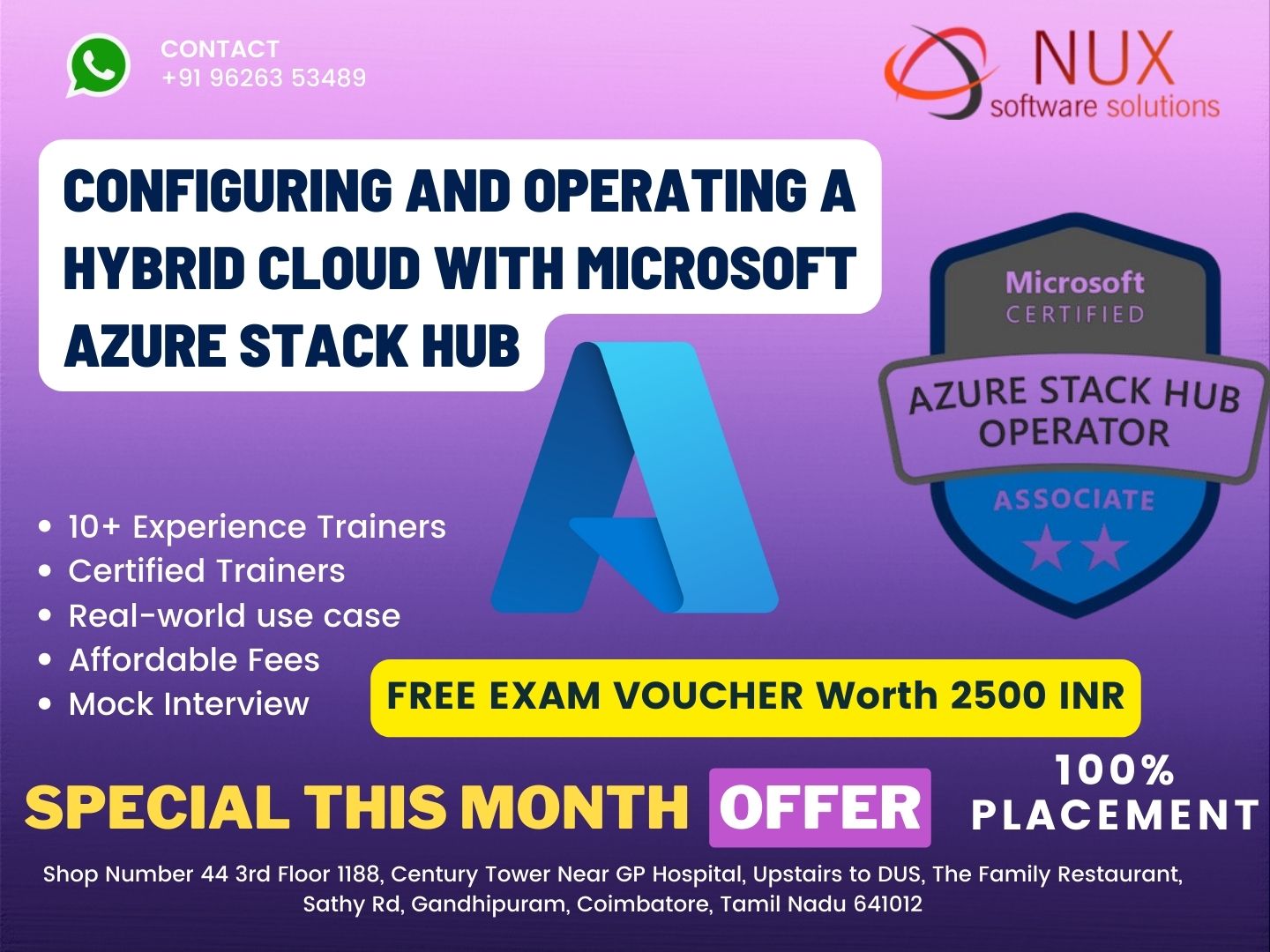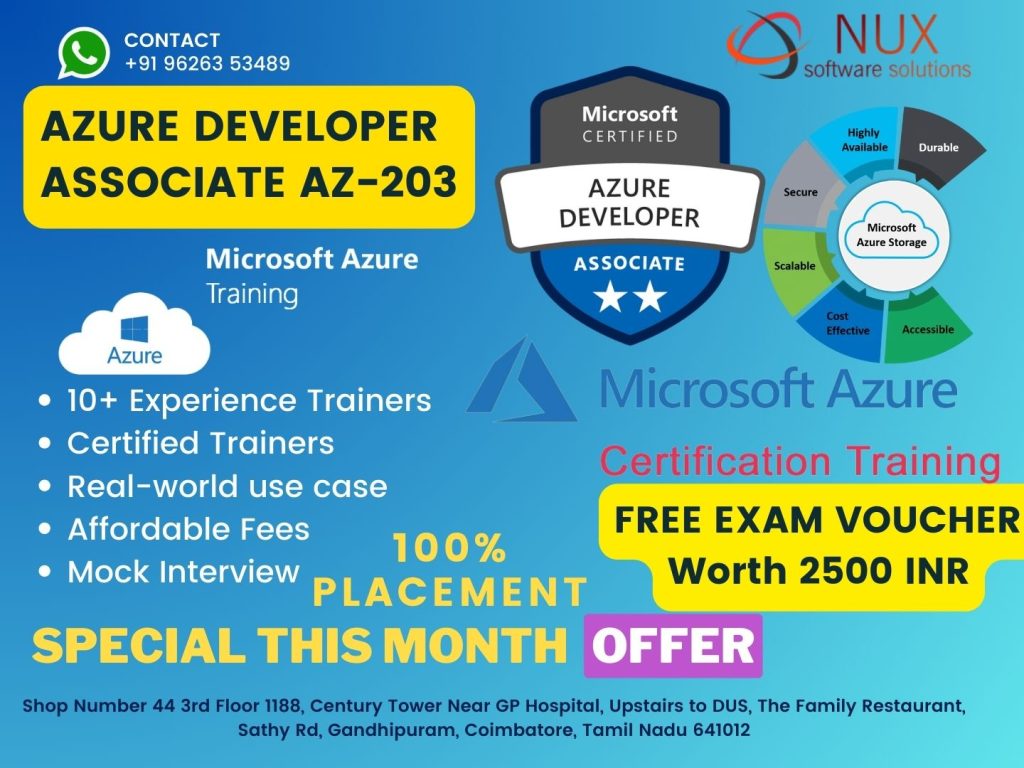Configuring and Operating a Hybrid Cloud with Microsoft Azure Stack Hub – AZ-600

Become a Microsoft Azure Stack Hub Expert with Nux Software Solutions
The “Configuring and Operating a Hybrid Cloud with Microsoft Azure Stack Hub – AZ-600” course is designed for IT professionals and cloud administrators who want to manage and operate hybrid cloud environments seamlessly using Azure Stack Hub. This certification course equips learners with the knowledge and hands-on skills needed to plan, deploy, configure, secure, and monitor Azure Stack Hub infrastructure in real-world enterprise environments.
At Linux Training Center in Coimbatore, we offer a focused training program that blends conceptual clarity with real-time labs, helping participants master hybrid infrastructure solutions that combine the power of Microsoft Azure with on-premises datacenters. You’ll learn how to integrate identity services, manage workloads, implement security measures, and provide services to tenants in a consistent hybrid environment.
The course is aligned with the AZ-600 exam objectives and supports professionals in becoming Microsoft Certified: Azure Stack Hub Operators Associate.
Who Should Enroll?
This course is ideal for cloud administrators, system engineers, infrastructure architects, IT professionals working in hybrid environments, and anyone responsible for delivering Azure services using Azure Stack Hub. It’s also suitable for individuals preparing for the AZ-600 certification to validate their hybrid cloud skills.
What You Will Learn
You’ll learn to configure and operate Azure Stack Hub infrastructure, manage identity and access, deploy and manage workloads, implement data center integration, ensure business continuity, monitor system health, and maintain hybrid network connectivity between Azure and on-premises systems. You’ll also gain real-world skills in using ARM templates, role-based access control (RBAC), and Azure Monitor for a unified management experience.
Prerequisites
A solid understanding of Microsoft Azure, networking, virtualization, and Windows Server administration is recommended. Prior experience with PowerShell and familiarity with concepts like Active Directory and virtual networking will enhance learning. We also provide foundational resources to help you get up to speed if you are new to Azure Stack.
Course Benefits
100% exam-aligned content for AZ-600 certification, real-time hands-on lab access to hybrid cloud infrastructure, guided deployment exercises using Azure Stack Hub, mentorship by certified Microsoft Azure professionals, exam preparation and certification support, and post-training assistance for job placement in hybrid cloud roles.
Career Opportunities After Certification
Completing this course prepares you for roles such as Azure Stack Hub Operator, Hybrid Cloud Administrator, Azure Infrastructure Engineer, Cloud Systems Specialist, and Enterprise Hybrid Cloud Consultant across industries that require secure and scalable cloud integration.
Empower your IT career with hybrid cloud expertise by enrolling in the AZ-600 course at Linux Training Center, Coimbatore. Learn to manage and operate Microsoft Azure Stack Hub environments from certified experts and gain hands-on experience that leads to certification and job success.
Enroll now and take the next step toward becoming a Microsoft-certified Hybrid Cloud Specialist. Contact us today to join the upcoming batch.
Configuring and Operating a Hybrid Cloud with Microsoft Azure Stack Hub – AZ-600 Syllabus
Modules
Analyze solution requirements (25-30%)
Plan and deploy Azure Stack Hub (30–35%)
Plan an Azure Stack Hub deployment
Recommend a deployment model for a specific scenario
Recommend a name resolution strategy
Define fully qualified domain name (FQDN) and region name
Recommend a public and internal IP strategy
Define static routes or Border Gateway Protocol (BGP) configuration
Recommend a datacenter firewall integration strategy
Choose between Microsoft Entra ID and Active Directory Federation Services (AD FS)
Validate identity provider and network by using the Azure Stack Hub Readiness Checker tool
Select a billing model
Plan and implement infrastructure certificates for Azure Stack Hub
Choose between an Enterprise certificate authority (CA) and a public certificate
Prepare certificates for Azure Stack Hub
Import certificates
Export PFX files
Prepare folder structure
Validate certificates by using the Azure Stack Hub Readiness Checker tool
Rotate secrets for certificates
Manage Azure Stack Hub registration and billing
Recommend a registration model
Register in a connected environment
Register in a disconnected environment
Validate Azure Stack Hub registration
Refresh Azure Stack Hub registration
Set up usage data reporting
View and retrieve usage data by using the usage API
Manage usage and billing in multitenant and cloud solution provider (CSP) scenarios
Set up management environment
Obtain and connect to Azure Resource Manager endpoints
Download and deploy Operator Access Workstation
Install PowerShell modules for Azure Stack Hub
Enable Azure CLI for Azure Stack Hub users
Download and deploy Azure Stack PowerShell tools
Add relevant environment based on a scenario
Enable the Emergency VM Access Service (EVA)
Provide services (20–25%)
Manage Azure Stack Hub Marketplace
Populate Azure Stack Hub Marketplace from a connected environment
Populate Azure Stack Hub Marketplace in a disconnected environment
Create a custom Azure Stack Hub Marketplace item
Manage the lifecycle for Azure Stack Hub Marketplace items
Create an ARM template
Offer the Azure App Service resource provider
Plan the App Service resource provider deployment
Deploy the App Service resource provider
Update the App Service resource provider
Scale roles based on capacity requirements
Rotate App Service secrets and certificates
Manage and monitor worker tiers
Back up App Service resource provider, including SQL databases, file server share, and secrets
Offer the Azure Event Hubs resource provider
Plan an Event Hubs resource provider deployment
Deploy an Event Hubs resource provider
Update an Event Hubs resource provider
Rotate Event Hubs secrets and certificates
Offer services
Create and manage quotas
Create and manage plans
Create and manage offers
Create and manage user subscriptions
Change user subscription owner
Manage infrastructure (40–45%)
Manage identity and access
Assign users and groups in Azure Stack Hub
Grant an app access to resources
Define a custom role in Microsoft Entra ID for delegating Azure Stack Hub management tasks to users
Register a tenant directory with Azure Stack Hub
Update a tenant directory
Unregister a tenant directory
Monitor and maintain system health
Monitor system health by using the administrator portal
Monitor system health by using PowerShell
Monitor system health by using the REST API
Respond to and manage alerts
Validate health and system status by using Test-AzureStack
Monitor Azure Stack Hub infrastructure certificates
Collect diagnostic logs on demand by using the administrator portal
Collect diagnostic logs on demand by using the privileged endpoint
Configure automatic diagnostic log collection
Configure syslog forwarding for Azure Stack Hub infrastructure
Plan and configure business continuity and disaster recovery (BCDR)
Retrieve BitLocker recovery keys
Recommend a BCDR strategy
Recommend a solution for tenant backups
Choose a method for infrastructure backups
Configure storage target for infrastructure backups
Configure certificates for infrastructure backups
Configure frequency and retention policy for infrastructure backups
Test backup and restore of infrastructure by using Azure Stack Development Kit
Enable backup by using PowerShell
Validate success status of backup
Perform node and system-wide operations
Add nodes
Manage storage capacity by reclaiming space or rebalancing
Add IP pools
Stop and start Azure Stack Hub
Perform node operations, including start, stop, resume, repair, drain, and shutdown
Configure Time Server (NTP)
Configure syslog server
Configure DNS server
Update Azure Stack Hub, including scheduling, deploying, monitoring, and troubleshooting
Update Microsoft Entra home directory
Configure and use privileged endpoints
Connect to a privileged endpoint
Configure the cloud admin user role
Unlock a support session
Close the session on the privileged endpoint



